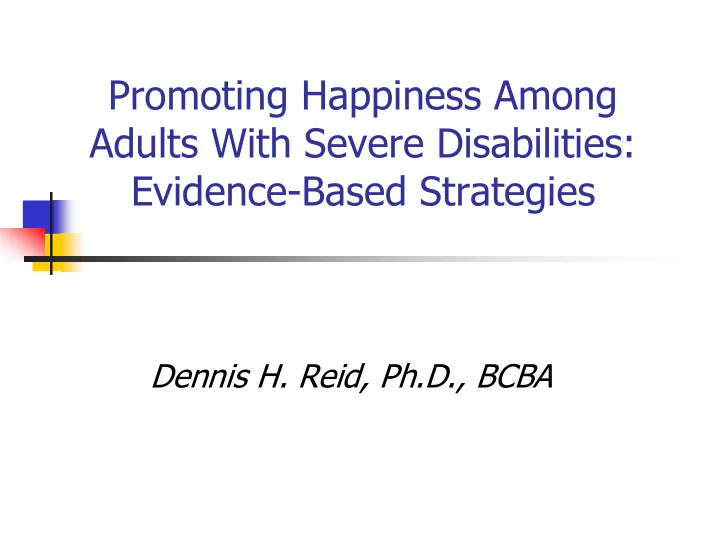

Promoting Happiness Among Adults With Severe Disabilities: Evidence-Based Strategies Dennis H. Reid, Ph.D., BCBA
Why Focus on Happiness? Pursuit of happiness is a fundamental right Happiness a primary concern of family members Reductions in problem behavior
Early ABA Reference to Private Event of Happiness Wolf, M. M. (1978). Social validity. . . Or how ABA is finding its heart. JABA, 11, 203-214. Hits importance of things like happiness By the first editor of ABA’s flagship editor But since then . . .
In Some Ways, Happiness a Risky Venture in ABA A private event Usually measured by verbal report – can be risky Verbal reports very difficult for people who lack vocal communication Still, happiness is viewed by society as important . . . For people with intellectual disabilities, it should not be taken for granted; it should be targeted and addressed like any other desired outcome
Qualifications Happiness on day-to-day basis vs. major lifestyle changes Focus on happiness and personal growth That is, not in place of personal growth
Evidence-Based Protocol to Promote Happiness Identify indices of happiness and unhappiness Validate identified indices Act to increase situations accompanied by happiness indices Act to decrease situations accompanied by unhappiness indices Monitor and evaluate routinely
Identifying Indices of Happiness and Unhappiness Common indices Happiness: smiling, laughing, yelling while smiling Unhappiness: frowning, grimacing, crying, yelling without smiling Qualification for people with severe disabilities
Identifying Happiness Indices: Caregiver Opinion Common practice Concerns with validity To promote validity: Ensure familiarity of caregivers Obtain caregiver consensus
Identifying Happiness Indices: Preference Assessments How preference assessments relate to indices of happiness and unhappiness
Validating Happiness and Unhappiness Indices Identify situations in which a person usually experiences happiness and unhappiness Observe indices in above situations Compare occurrence of indices across situations Provide repeated choices
REFERENCE Identifying and Validating Indices of Happiness and Unhappiness among Adults with Autism (and severe intellectual disabilities) Parsons, M. B., Reid, D. H., Bentley, E., Inman, A., & Lattimore, L. P. (2012). Identifying indices of happiness and unhappiness among adults with autism: Potential targets for behavioral assessment and intervention. Behavior Analysis in Practice,5, 15-25 www.abainternational.org
Increasing Happiness The importance of personal relationships Role of familiarity of staff Preferred vs. nonpreferred status of staff
Familiarizing New Staff for Working with Adults Severe Disabilities: A Case for Relationship Building Parsons, M.B., Bentley, E., Solari, T., & Reid, D.H. (in press). Behavior Analysis in Practice
Purpose Evaluate effects of familiar vs. unfamiliar staff on behavior of adults with autism on severe end of spectrum Evaluate effects of a familiarization process for new staff
General Procedures Setting (work focus) Participants 4 men with features of autism on the severe end of the spectrum DVs: happiness and unhappiness indices, compliance, problem behavior, on task Familiarization program: fun time and phase-in
Developing a Relationship: Summary Spend time doing things that the person likes to do Fun Time Program Establish familiarity (phase-in) Occurrence of happiness indices during interactions suggests a good relationship
Increasing Happiness The power of pleasant social attention Impact on some problem behavior
Increasing Happiness Providing individual choices Choice opportunities must be provided based on individual skill level for responding with a meaningful choice
Increasing Happiness Accessing preferences Two-step process 1) identify individual preferences 2) embed in daily activities Initial procedure to reduce problem behavior
Increasing Happiness by Reducing Unhappiness Rationale: continuum of happiness and unhappiness Impact on some problem behavior Process Identify situation with unhappiness indices Eliminate the situation if possible Alter the situation
Making Undesired Activities More Enjoyable: Example Preference-Based Teaching Reid & Green (2005) www.behaviordevelopmentsolutions.com Rationale Some learners engage in challenging behavior to escape or avoid teaching programs If teaching programs are fun, no need for challenging behavior
To Effectively Promote Happiness . . . Happiness should be a goaled, desired outcome just like more traditional outcomes Must have behavioral objectives for monitoring and increasing/maintaining happiness (indices)
Don’t Forget Support Staff It is unlikely staff will effectively promote consumer happiness if staff are frequently discontented with their work environment
Reference for Increasing Happiness Reid, D.H. (2016). Promoting Happiness Among Adults with Autism and Other Severe Disabilities: Evidence-Based Strategies. www.behaviordevelopmentsolutions.com
Contact: Denny Reid; drhmc@vistatech.net FINALLY, IN YOUR SUPPORT SETTING, HOW OFTEN DO YOU SEE INDICES OF HAPPINESS AMONG THE PEOPLE YOU SUPPORT?
Recommend
More recommend